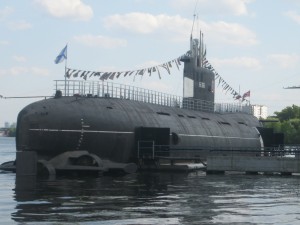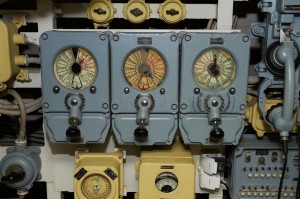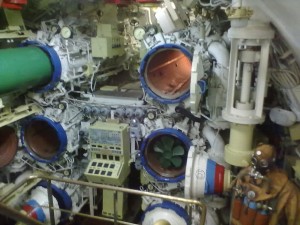Submarine Museum
This is a visit to the Russian Navy Museum at Tushino Reservoir, Moscow and the marvellous example of a Tango class Soviet Attack Submarine ‘B396’.
Soviet Navy was one of the important elements of the old USSR defence establishment. Numbering close on 500,000 personal and active globally with permanent presences in Conakry, Guinea; Havana, Cuba; Berbera, Somalia; and operations in Mauritius, Vietnam,
Mozambique and Angola the Soviet Navy was at the foremost of projecting Soviet power during the Cold War.
Ships have always been a technical barometer of their state and time. You can estimate a country’s economic potential and its’ scientific development looking at its’ ships. History shows that ‘progressive’ or leading countries could create and maintained large navies.
The development of the submarines completely changed strategy and tactics of naval battles. The craft enabled effective under water military campaigns; evolving from the primitive steam-powered to almost noiseless nuclear powered submarines, that could spend months hidden at sea equipped with their awesomely powerful multiple warhead intercontinental missiles.
In its’ day the object of our visit was classified: ‘Podvodnaya Lodka’ (PL); Submarine. The ship builders were ‘Krasnoye Sormovo Zavod 122, at the then very much closed City of Gorky (now of course known as Nizhniy Novgorod). Gorky City, 400 kms north east of Moscow was the proud custodian of some very high bridges that of course allowed the Soviet vessels to float up river under cover of darkness away from the prying eyes of
western spies!
She was innovative for the USSR, having the most advanced weaponry of the day and  modern (then) navigational and hydro-acoustic aides on board. Compared with the predecessor ‘Foxtrot’ class of submarine she had much bigger electric batteries increasing her underwater range and capacity; with tractable horizontal steering ‘handle bars’ hidden in her hull (when withdrawn the submarine was much faster and would massively reduce her acoustic signature by which the enemy would try and locate her presence); and other means of sonar (underwater radar) protection such as rubber-like covers which would deflect the detecting radar “sonar- waves” sent by enemy ships.
modern (then) navigational and hydro-acoustic aides on board. Compared with the predecessor ‘Foxtrot’ class of submarine she had much bigger electric batteries increasing her underwater range and capacity; with tractable horizontal steering ‘handle bars’ hidden in her hull (when withdrawn the submarine was much faster and would massively reduce her acoustic signature by which the enemy would try and locate her presence); and other means of sonar (underwater radar) protection such as rubber-like covers which would deflect the detecting radar “sonar- waves” sent by enemy ships.
In general, B396 is a huge construction, displacing 3566 tons when submerged.
The big diesel submarine B-396 was brought to Moscow in 2003. An entirely Soviet project, she now changed her Soviet ‘Red Banner’ Flag to that of the modern Russian Navy, the Cross of St. Andrew’s that is both the pre 1917 Revolution and post-Soviet Russian Naval symbol.
The ship is divided in 7 compartments. The first thing that jumps into your eyes is the huge afore mentioned torpedoes, weighting 2 tones each. There are several vertical and horizontal rows of them, 16 on each side of the boat. Not to forget some mines, of course.
The left-hand side is preserved to feed visitors’ curiosity whilst the right side is removed to enlarge the passage and provide access. Nevertheless, even the 16 torpedoes left looked
impressive and daunting.
The space between right and left sides (crammed with torpedoes) equalled 1 meter. And they filled it in with the beds for the crew! (Obviously, so not to waste any precious free space). Even the crews were chosen for their height.
Imagine all the romance of a voyage sleeping in intimate proximity with 78 ship mates and 32 2-ton torpedoes?! 6 torpedoes (right in front of your sleeping place) were permanently loaded, according to Soviet Naval doctrine, in the torpedo tubes. If a submarine suffered an accident these tubes provided the emergency escape exit. But, only if the submarine was no deeper than 100 meters; in that cases lady- luck would take you to safety – or not.
